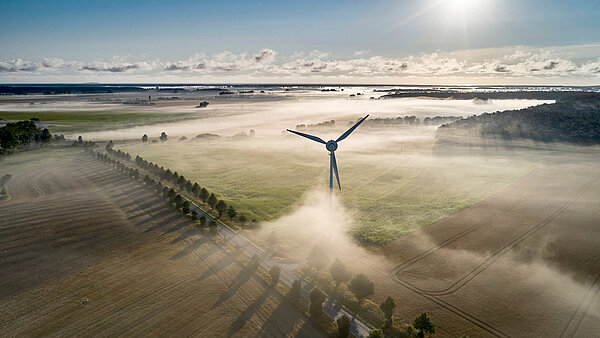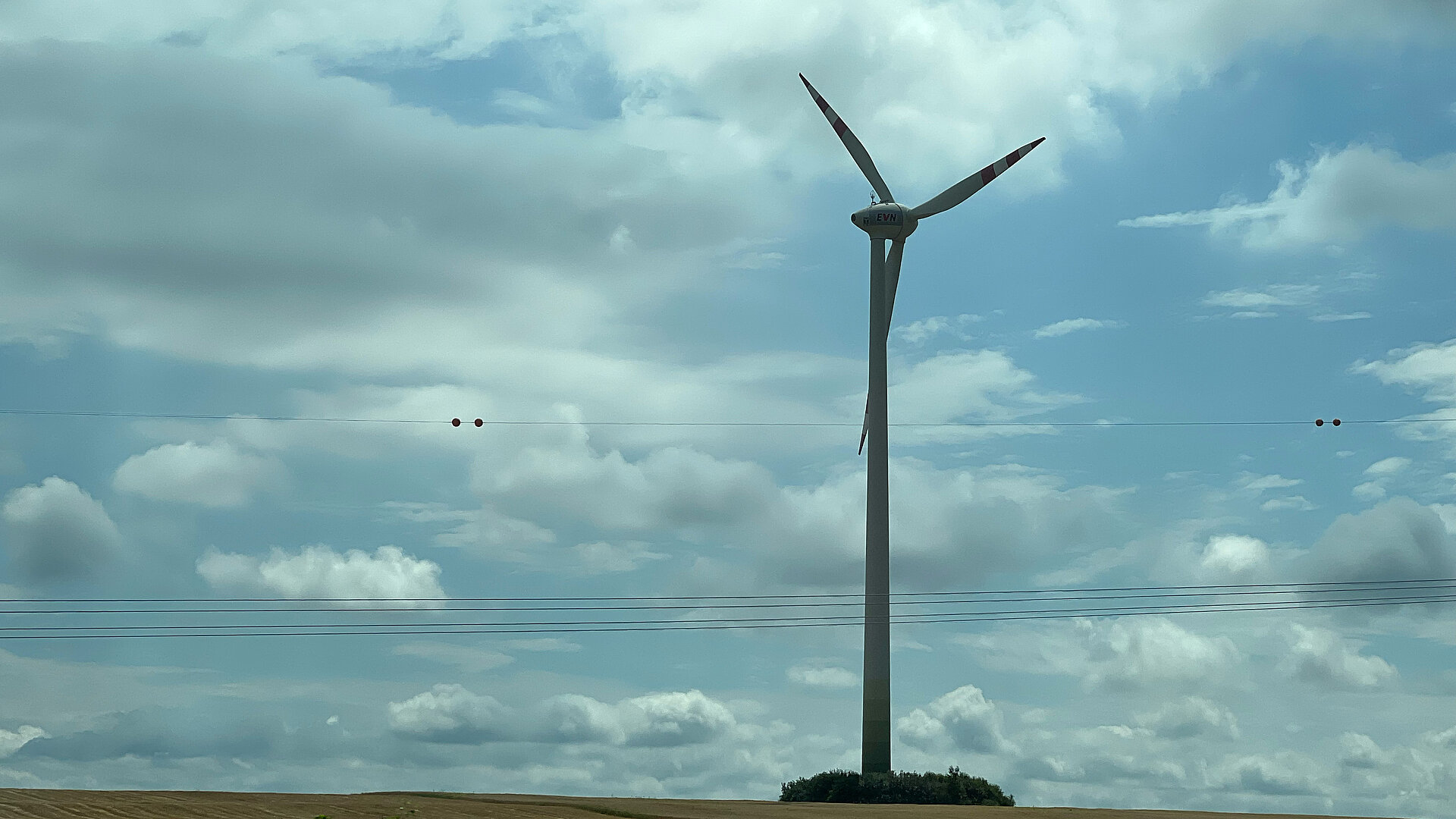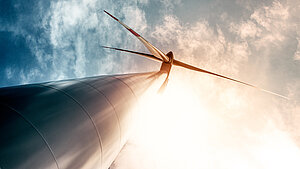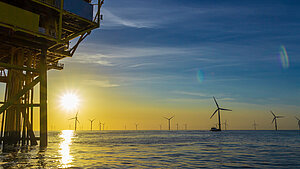In Germany and Austria, the importance of wind turbines continues to increase. In both countries, wind energy is a central component of the renewable energy portfolio. In 2020 in Germany alone around 132,000 GWh of electrical power were generated through wind force (Source: https://www.umweltbundesamt.de/themen/klima-energie/erneuerbare-energien/erneuerbare-energien-in-zahlen#strom).
In Austria, a water-power country, by 2021 75% of the power requirement was already covered by renewable energies (Source: https://www.umweltbundesamt.at/energie/erneuerbare-energie). In Austria too, between 2005 and 2021 the annual wind power capacity increased by more than 9%. In 2022 8.3 billion kWh were generated in Austria through wind power. A sharply rising trend, both in Austria and Germany.
Because wind turbines are one of the most dangerous workplaces in terms of industrial safety, it is natural that fall protection systems and safety solutions are currently gaining in importance in this regard. This article provides you with all relevant information about the legal requirements, technical solutions, and developments in the area of safety.
Wind power and safety for service technicians
The basic requirement for creating safety on and in wind turbines is the use of certified, professional safety solutions. Because, in order to keep the turbines in good condition and to be able to perform possible maintenance tasks or repairs on the turbine, the service technicians are almost permanently located in the fall risk area. In addition to this, various weather effects are in play on the roof of a wind turbine, and these affect the tasks and the safety factor.
The most important safety aspects for wind turbines:
- A detailed risk assessment with all danger sources for the respective project.
- A well-founded, comprehensive safety concept.
- Practical, user-friendly systems in combination with the appropriate personal protective equipment (PPE).
- Solid training of the service technicians on the safety solutions which are to be used.
- Service technicians’ own sense of responsibility regarding the correct use of the safety system
What you should look out for when choosing your fall protection system for wind turbines
It is of fundamental importance that the fall protection system is optimally adapted to the corresponding wind turbine. This requires the safety solution to be planned in good time. In addition, it needs to be conceived in such a way that incorrect use can be prevented in advance. This can be achieved only through the user-friendliness of the fall protection system, and appropriate training.
In principle the following systems can generally be used on wind turbines:
- Potential special solutions and combinations of the various systems
“The most important thing is the system’s user-friendliness”, emphasises Birk Schütte, Management Consultant for Industrial Safety at RelyOn Nutec Germany GmbH. “To be accepted and used by the worker, a fall protection system must function perfectly and be capable of intuitive operation”, continues the expert for safety and expertise services, in a discussion with INNOTECH. You can read the whole interview in the blog post: “What happens when something happens? - Birk Schütte in an interview about rescue training for wind turbine technicians”.
Further development through dialogue
As in many other industries and areas, for manufacturers of safety solutions for wind turbines, it is also necessary to continuously share information with operators, service technicians, and training institutions. This is the only way that existing systems can be optimised and/or modernised. And because the wind turbines themselves also continue to develop, safety concepts and solutions permanently require adaptation, in order that they can 100% satisfy the challenges which this may have created.
And, as Birk Schütte so splendidly formulated above, the fall protection system, including all connectors and associated products, must be easily comprehensible and simple to use, because the human being itself is always a “risk factor” for safety on wind turbines, and poorly positioned systems or awkward operability creates the risk that the fall protection system is not used correctly.
Birk Schütte therefore appeals to manufacturers of fall protection systems to “keep a very close eye on the weakest link in the chain”. This is the only way to ensure that all service technicians and employees, “regardless of any previous experience”, are able to deploy the safety solution correctly.
INNOTECH has always relied on close collaboration with training providers, experts from the relevant industry, etc. to continuously improve its own products. For that reason the online video format INNO|talk was created. For this, experts from the most varied sections of a specific industry were invited to discussions, in order to share information about potential improvements in terms of safety. From these discussions, INNOTECH continues to gather very interesting, practical tips, which can then feed directly into the further development of the safety solutions.
INNO|talk on the importance of fall protection systems for wind turbines
INNOTECH also invited experts to a talk about safety in and on wind turbines. Marc Wollschläger, Head of Sales BWTS GmbH, and Michael Pett, Head of Sales at INNOTECH Germany provided detailed insights into the daily work of service technicians and rescue trainers, who perform their training directly on wind turbines in order to achieve maximum practical relevance. This complete INNO|talk is available here.
The sources of danger on and in wind turbines
Our experience and the exchange with experts from the wind power industry demonstrate that the danger areas and sources can vary, depending, for example, on the type and structure of the wind turbine, and on the safety system which is present. However, in principle, four sources of danger may be emphasised:
- Danger source 1: Incorrect uses of the available safety system.
When it comes to incorrect use, demanding requirements are placed on fall protection systems. But nevertheless the user of the safety solution bears great responsibility in terms of use. Legal requirements and directives (e.g. DGUV 112-198/199 for anti-fall PPE) must be complied with in order that incorrect use and the risk of falls can be avoided.
- Danger source 2: Vertical ascent and descent along the ladder.
The height of the wind turbine… a danger source in itself, because in general ascent and descent must take place in order to get to the nacelle and back. In the event of a worst case scenario, it must be possible to take action at any time, as per the rescue concept. For this reason, when descending a ladder in an emergency, the focus should above all be on the ease of movement within the safety system, and on rapidity.
- Danger source 3: Single anchor points which are badly positioned or non-existent.
For maintenance tasks or to take a break, service technicians must be able to access rest platforms during a vertical ascent. For this, a transition from the ladder to the platform is necessary. An increased fall risk exists here! Detaching/re-attaching is often made more difficult through anchor points which are not optimally positioned. In addition, there is the risk that any sharp edges present cut through the lanyard.
- Danger source 4: Effects of weather on the roof of the wind turbine.
When accessing the roof of the turbine, external effects caused by bad weather also represent an increased danger source.
The service technicians working on wind turbines need to be secured by means of professional, practical fall protection. For this, rail systems such as the TAURUS, that do not bind or jam, in combination with SINGLE ANCHOR POINTS provide the best solution. With the TAURUS rail system, continuous protection can be created for the vertical ascent/descent, including transition to the rest platforms.
And also on the roof of the wind turbine, TAURUS provides continuous protection along the fall edge, completely without detaching/re-attaching. Thanks to the system’s user friendliness, the service technicians can concentrate fully on their tasks. All in all, that saves a great deal of time. In addition, these rail systems can themselves be used as an anchor point, if it happens that a service technician or employee has to be rescued or roped down.
Being prepared for an emergency
Professional, certified fall protection systems save lives! An emergency also means being able to rescue casualties from wind turbines. This is where professional rescue training plays a decisive role. This not only teaches the correct handling of the relevant safety solutions, but the rescue chain is also examined in detail, so the affected service technicians keep their nerve even in an emergency, and are able to instigate all necessary rescue and recovery measures as quickly as possible. This also requires that very good first aid knowledge has been internalised.
In an emergency, the time factor plays a decisive role. And the best way to significantly beat time is through optimally trained service technicians and a modern fall protection system. Because only the only way that the necessary actions become embedded is through good evacuation exercises and intensive training on the fall protection system in effective rescue measures. INNOTECH provides various training programmes on their fall protection systems . These include specialist, rescue, and anti-fall PPE training.
Attention: These types of training are legally mandated in Germany and Austria, and must also be refreshed annually.
Important addresses and standards in Germany and Austria
Digression: Onshore vs. Offshore
In principle, the difference between onshore and offshore wind turbines is easily explained. Onshore turbines are installed on land, and offshore power plants use the generally strong winds on the open sea to create energy. The consequence of this is that an offshore turbine is accessible only by boat or helicopter.
This is why, for onshore turbines, recovery or rescue of employees involved in an accident generally takes place downwards, while for offshore wind turbines, these activities can be performed only upwards, because downwards there is just water. In addition, wind turbines at sea are usually built to greater dimensions, and therefore each creates more power. However, under closer consideration, a few more differences which play a role in safety reveal themselves between the two turbine types.
Above all, on the outside of a wind turbine, onshore and offshore platforms differ significantly. Helicopters must be able to land on offshore wind turbines. They therefore mostly have a railing on the “roof” as a retention device against falls. This is not necessary for onshore turbines.
A look at practice – Gode Wind 2
A look at practice repeatedly shows that no two projects are the same. Every wind turbine creates completely different challenges in the planning and installation of the optimum professional, certified fall protection system. For example, the Gode Wind 2 offshore wind farm is located in the southern part of Germany’s North Sea, and each year it provides around 330,000 German households with renewable electricity. Following a risk analysis, those responsible for the wind farm decided to rely on new, modern safety solutions for the two transformers Shunt 1 and Shunt 2.
Their choice fell on the TAURUS-ALLROUND rail system in combination with the TAURUS GLEIT A-31. “We were quickly convinced that the solutions from INNOTECH were ideally suited to our project”, said the project managers. The reason for this was that the TAURUS ALLROUND is very versatile and optimally combines the advantages of the two systems TAURUS HORIZONTAL and TAURUS VERTIKAL.
It is possible to transition from a vertical ascent to a horizontal level without change of system, i.e. without detaching/re-attaching. The aluminium rails have the advantage of being extremely adaptable. It was thus possible to adapt them optimally to the existing circumstances of the shunts. Not just the exposed location on the high seas was a huge challenge for this project, but the shunts’ outer shell had not to be damaged in the course of installing the fall protection system. The TAURUS-ALLROUND system was therefore attached using clamps as a special solution.
Do not wait to contact us for more information! We will team up with you to find the right fall protection system for the wind turbines in your wind farm.
















